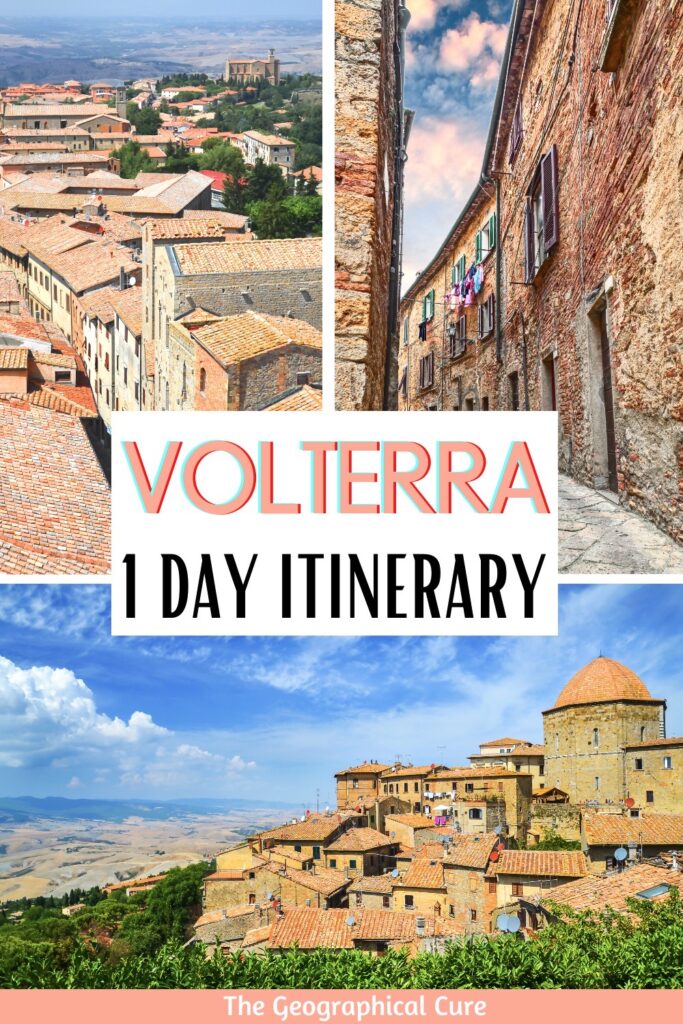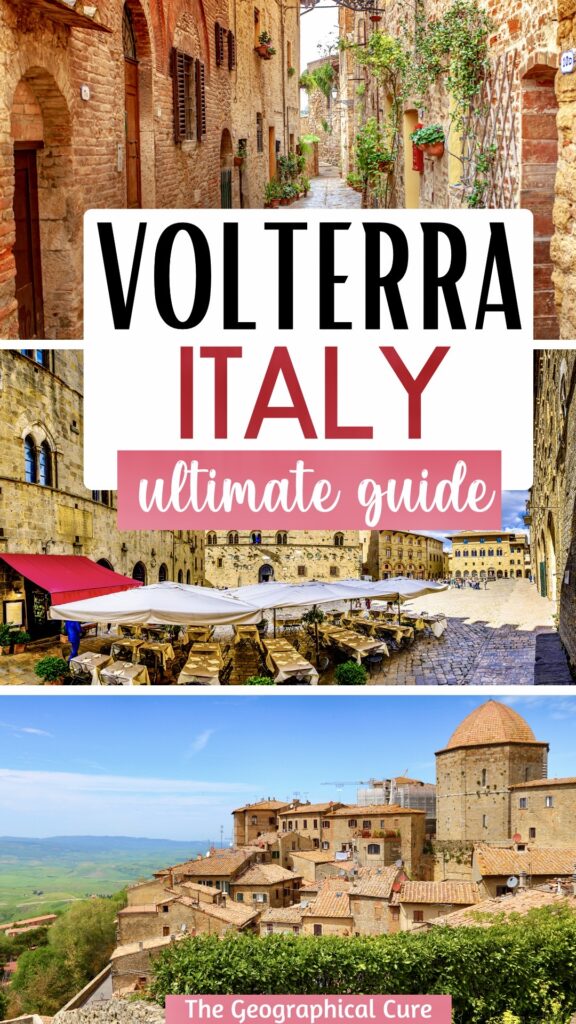Need a one day itinerary to explore the historic town of Volterra? Get ready for a delightful adventure!
With its stony medieval architecture, ancient Etruscan and Roman ruins, and breathtaking Tuscan landscapes, Volterra is the perfect destination for a day trip from Florence, Siena, or Pisa.
Nestled in the hills of Tuscany, Volterra is one of Italy’s most underrated hill towns. Despite its rustic vitality, the town’s out-of-the-way location keeps it from being trampled by too many visitors. And Volterra offers some of the best sightseeing of all of Tuscany’s small hill towns, with excellent museums and archaeological sites.
Overview Of One Day In Volterra Itinerary
Here’s a snapshot glance of what you’ll see with one day in Volterra.
- Roman Theater
- Etruscan Museum
- Piazza dei Priori
- Palazzo dei Priori
- Via Matteotti
- Porta all’Arco
- Duomo
- Baptistery
- Diocesan Museum
- Pinacoteca
- Alabaster Museum
I advise purchasing the Volterra Card, which will give you access to all the attractions I describe below. If you need a map, the tourist office is in the Piazza dei Priori. You may also want to book a guided walking tour of the town.
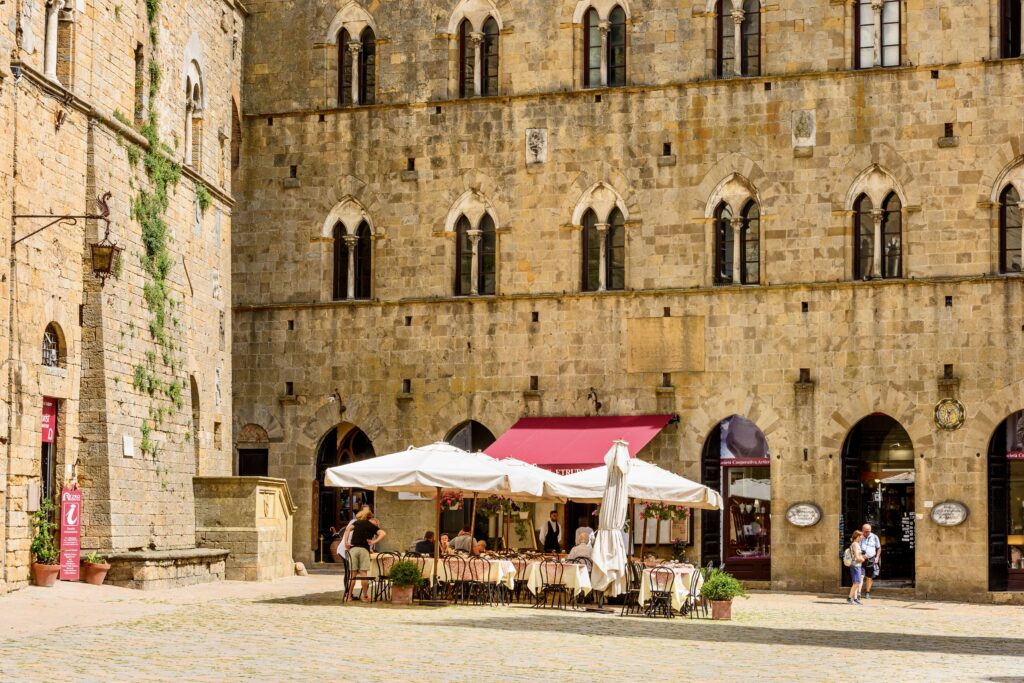
A Short History of Volterra
The Etruscans founded Volterra around the 8th century B.C.This civilization was really thriving in the region from the 8th to the 3rd century B.C. Volterra was at the center of it all – it was an incredibly prosperous city known for its skilled artisans and a bustling trading center.
In the 3rd century B.C., the Roman Republic came along and conquered Volterra. The city became an important center for mining and metalworking, famous for its production of alabaster. Even though the Romans took over, Volterra still retained much of its Etruscan identity.
Things changed again in the Middle Ages. Volterra was now a fortified city, constantly under attack from rival city-states in Tuscany. Despite all of the fighting, it became an important center for art and culture. Many famous artists and architects came through and left their mark on the city’s buildings.
In the Renaissance, the Medici dukes of Florence conquered Volterra. The town is not particularly know for its Renaissance works. But it did produce the painter and sculptor Daniele de Volterra, who was a follower of Michelangelo.
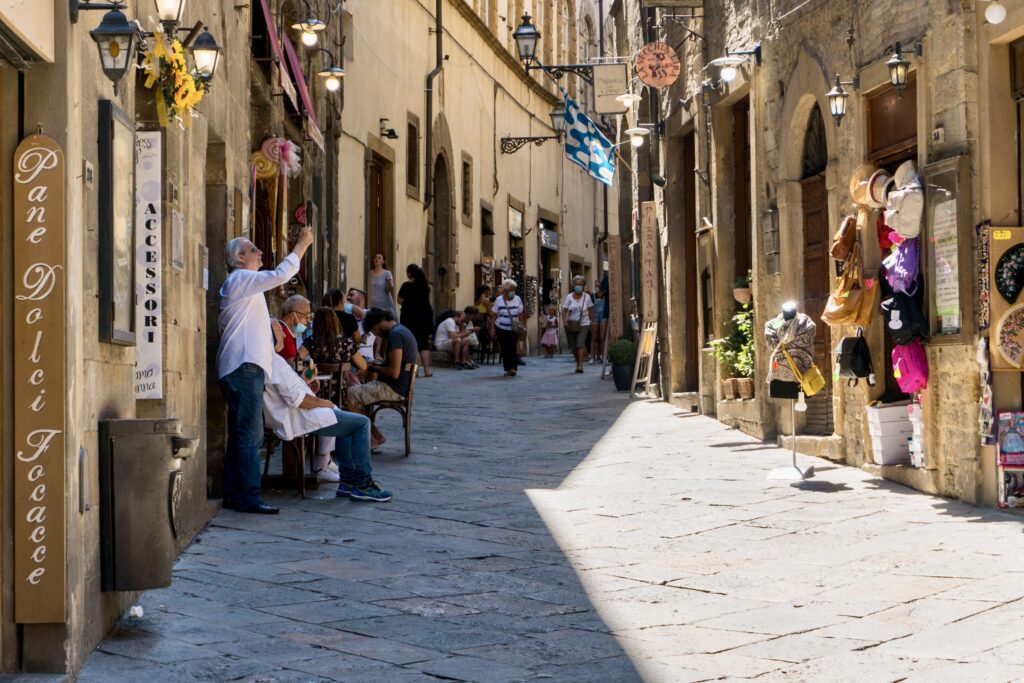
During this time, the city’s alabaster industry thrived. Volterra became well known for its intricate carvings and sculptures made from the stone.
Today, Volterra is a popular tourist destination known for its rich history, ancient ruins, and stunning views of the Tuscan countryside.
Though Volterra is still somewhat off the beaten track, the town gained fame when it was featured in the popular Twilight book and movie series. In the story, Volterra is home to the Volturi, a powerful coven of vampires.
Some of the filming locations included the Piazza dei Priori, the Palazzo dei Priori, and the Clock Tower.
One Day In Volterra Itinerary
Here is my suggested 1 day Volterra itinerary that covers the town’s most significant attractions. I also give you tips for visiting and more options if you have extra time in Volterra.
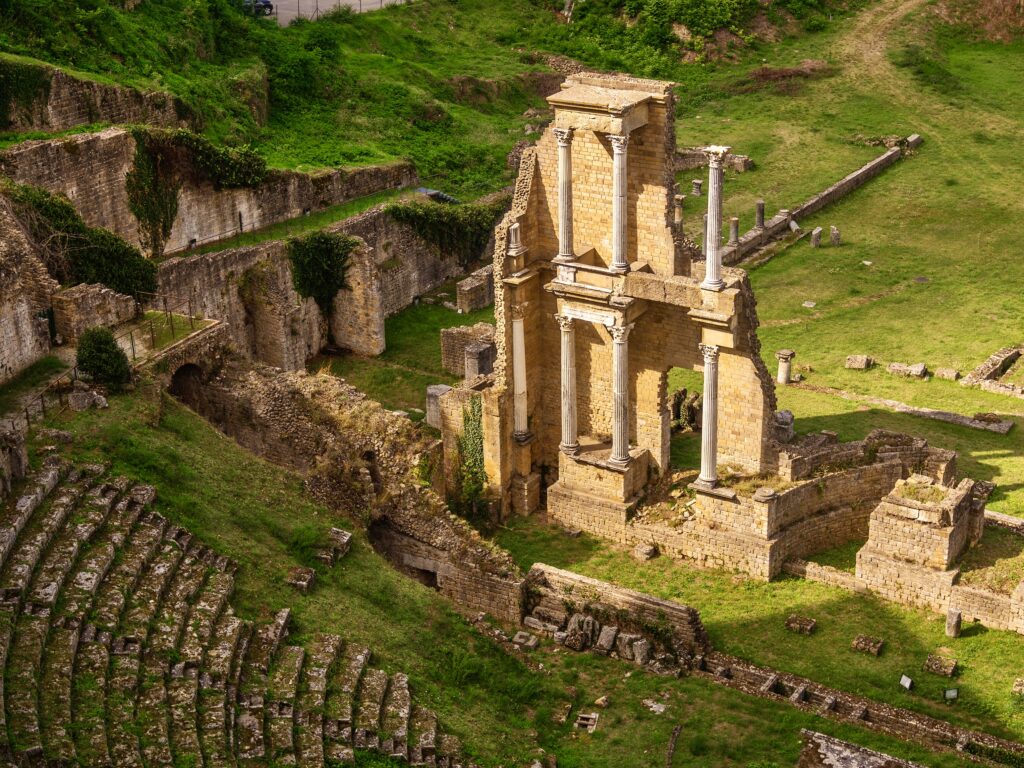
Roman Theater
To start your one day in Volterra itinerary, head over to the well-preserved Roman Theater. This ancient amphitheater dates back to the 1st century A.D. and is definitely worth a visit.
It’s outside the city walls and about a 10-15 minute walk from the historic center. You exit the Porta Fiorentina, an ancient Etruscan gate, to visit the theater.
Built during the 1st century B.C., the Roman Theater was once the site of various public events, such as theatrical performances, gladiator fights, and political assemblies.
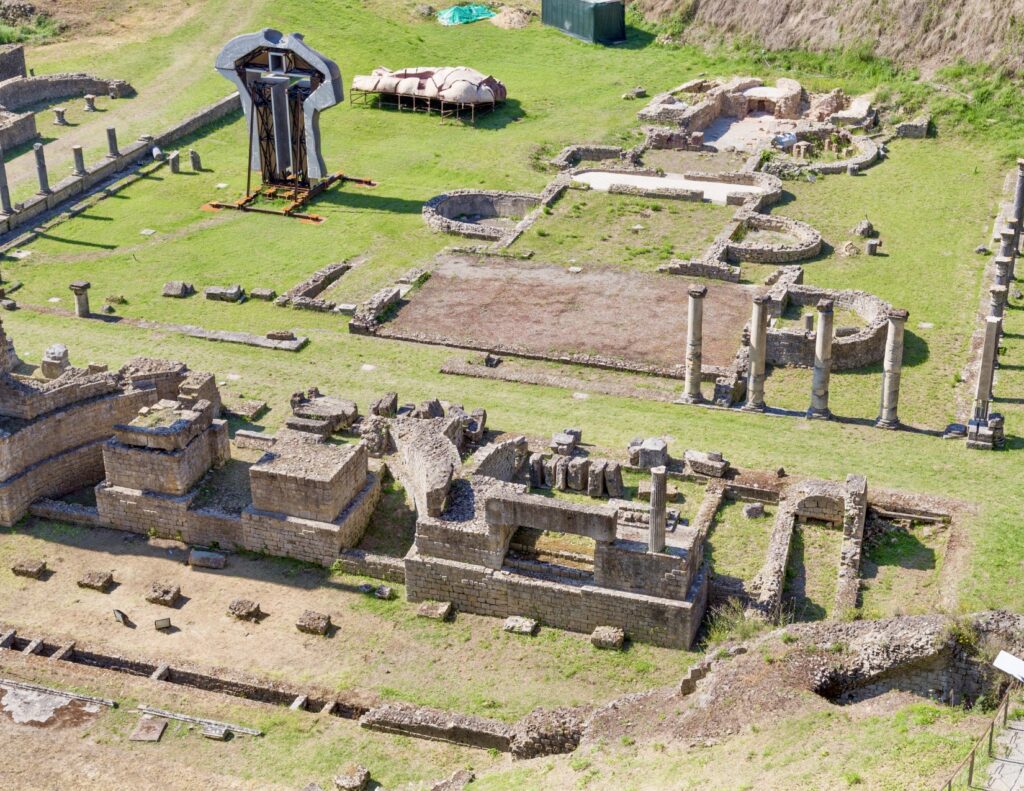
The theater is carved into the side of a hill and offers a glimpse into the world of Roman entertainment.
Visitors can explore the remains of the amphitheater, including the stage, seating areas, and backstage areas. You can also check out the small museum on site, which houses various artifacts and information about the history of the theater.
From the theater’s perch, you can enjoy stunning views of the surrounding countryside. You can also explore the ruins of a Roman acropolis and a 2nd century bath complex.
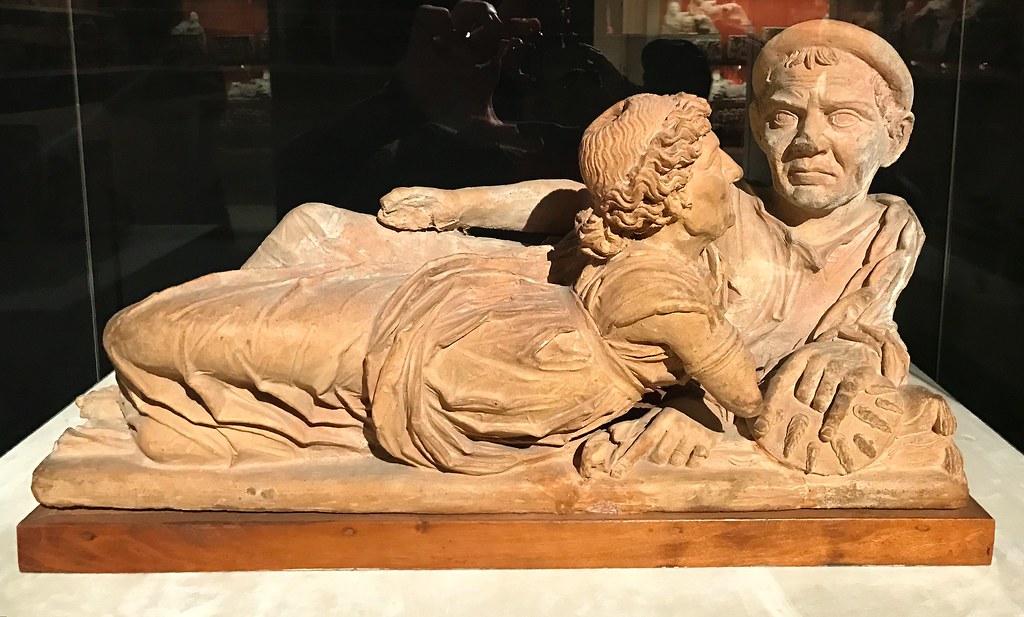
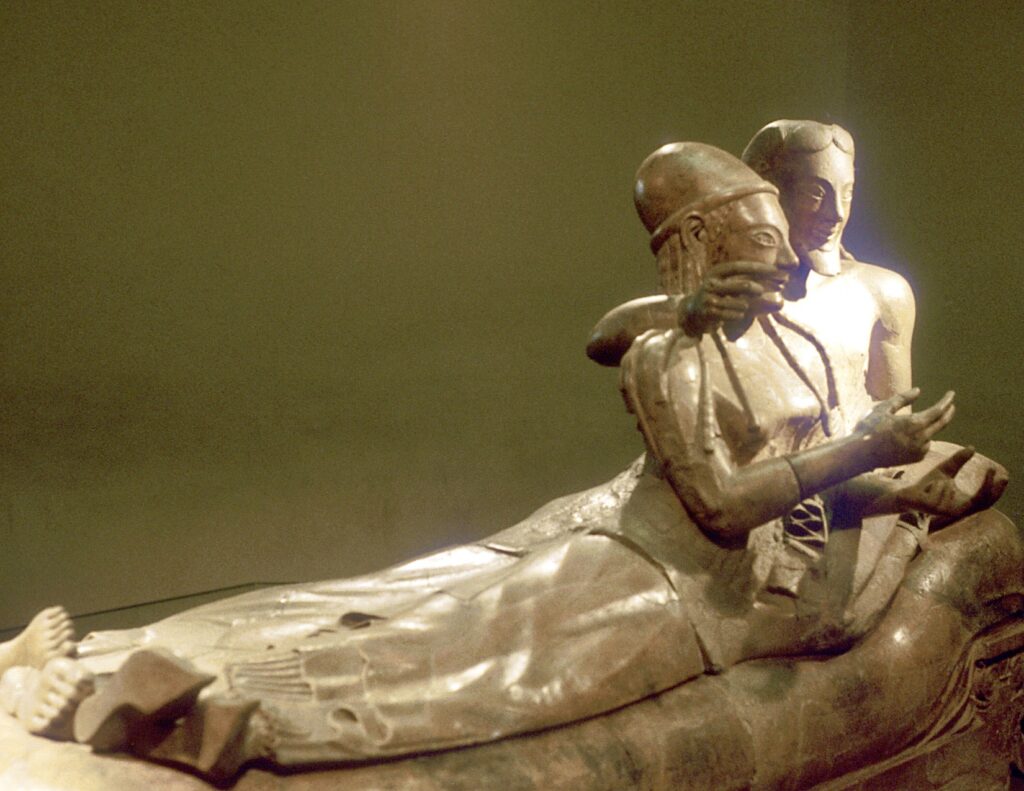
Etruscan Museum
Next, head to the Museo Etrusco Guarnacci. It’s housed in a beautiful medieval palace in the Piazza dei Priori and is one of the best archaeological museums in Italy outside Rome.
The museum houses an impressive collection of Etruscan artifacts, including stone carvings, pottery, jewelry, and sarcophagi. There are more than 600 urns!
While Etruscan art isn’t for everyone, there are some beautiful pieces, including the 1st century B.C. bronze sculpture Gli Sposi (Newlyweds) and the 3rd century B.C. Ombra della Sera (Shadow of the Evening).
There are signs in English and you can also get an audioguide.
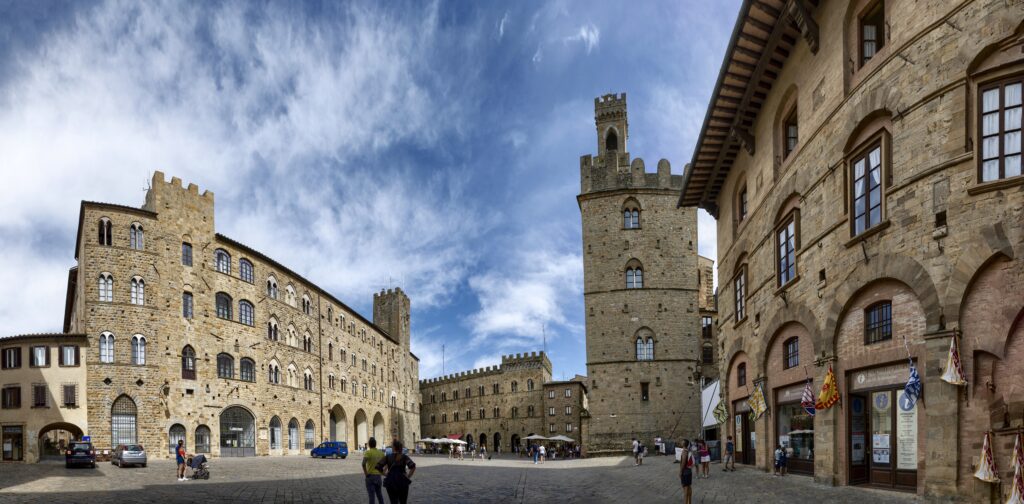
Piazza dei Priori
Next up is the Piazza dei Priori, Volterra’s main square. It’s considered one of the most beautiful medieval squares in Tuscany.
The piazza is located in the heart of the town and is surrounded by some of Volterra’s most important buildings.
Palazzo dei Priori
The Palazzo dei Priori is the oldest surviving public building in Tuscany. It’s a must see on any one day in Volterra itinerary. Click here to book a ticket.
The palace dates back to the 13th century and houses the city’s municipal offices, as well as a museum of art and archaeology. If you’ve been to Florence, you can tell that it was the model for the Palazzo Vecchio.
On the first floor, there are several rooms to explore, including the Sala del Consiglio and the Sala del Podestà. You’ll see a huge Annunciation fresco by Nicolo di Pietro Gerini and a canvas depicting the Wedding at Cana by Donato Mascagni.
But the main reason to visit the palazzo is to climb the bell tower. It’s called the Torre del Porcellaino, or Piglet’s Tower.
It’s named for a carved boar that sits near an upper floor window. You access the tower from the second floor of the palace. It’s 52 steps to the top for a bird’s eye view of Volterra and the countryside.
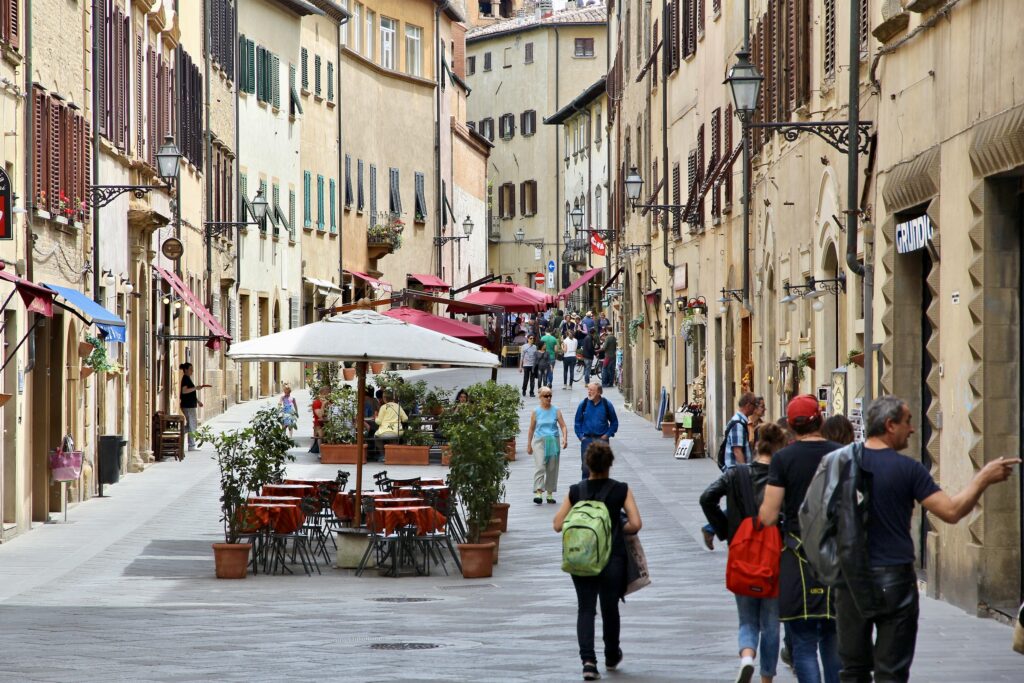
Via Matteotti
After your palace visit, take a stroll down the main drag, Via Matteotti. It’s lined with a mix of shops, restaurants, cafes, and historic buildings, making it a popular spot for both locals and tourists.
Take a break for lunch at one of the many restaurants. Try the local cuisine, such as the famous Volterra truffles, wild boar, or the Tuscan-style soup called ribollita.
You can also just grab a quick lunch, if you want to maximize sightseeing time. I got a delicious panini to go at Panineria A Vicolino.
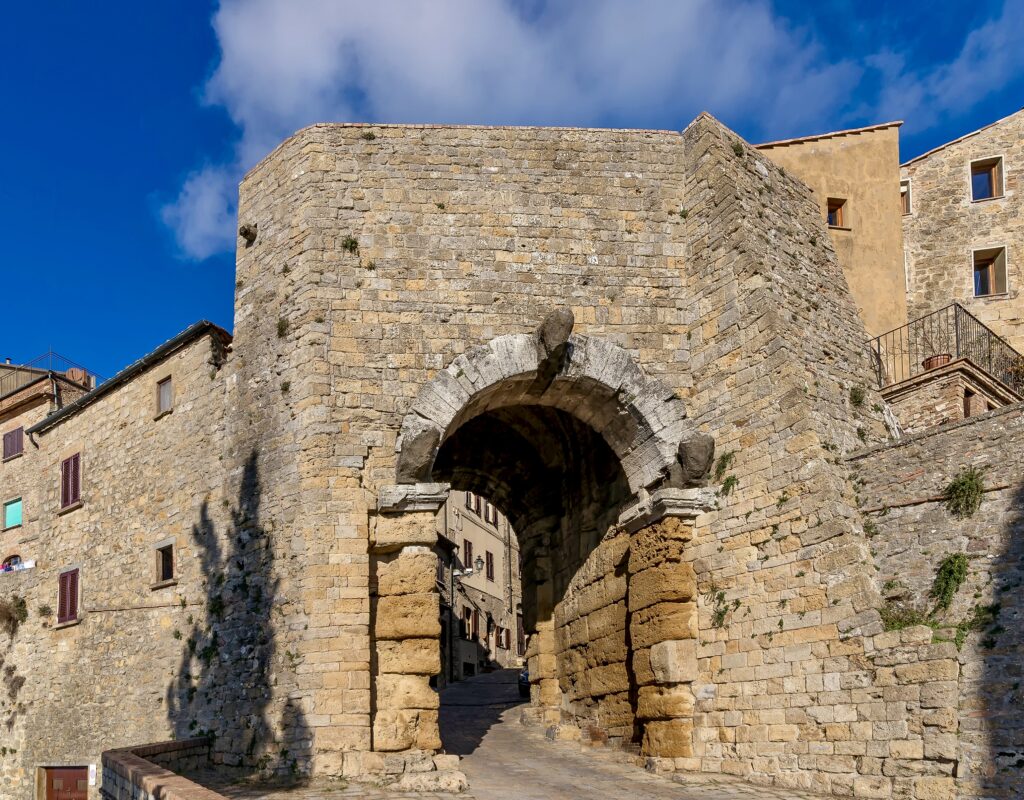
Porta all’Arco
The Porta all’Arco is an Etruscan archway that dates back to the 4th century BC. It’s one of the best-preserved Etruscan archways in Italy.
The archway is located on Via Porta all’Arco, which is a narrow street off the Piazza dei Priori.
The Porta all’Arco is made of large, rectangular stone blocks that are carefully cut and fitted together without the use of mortar. The archway has a simple, unadorned design with a large, semicircular arch typical of Etruscan architecture.
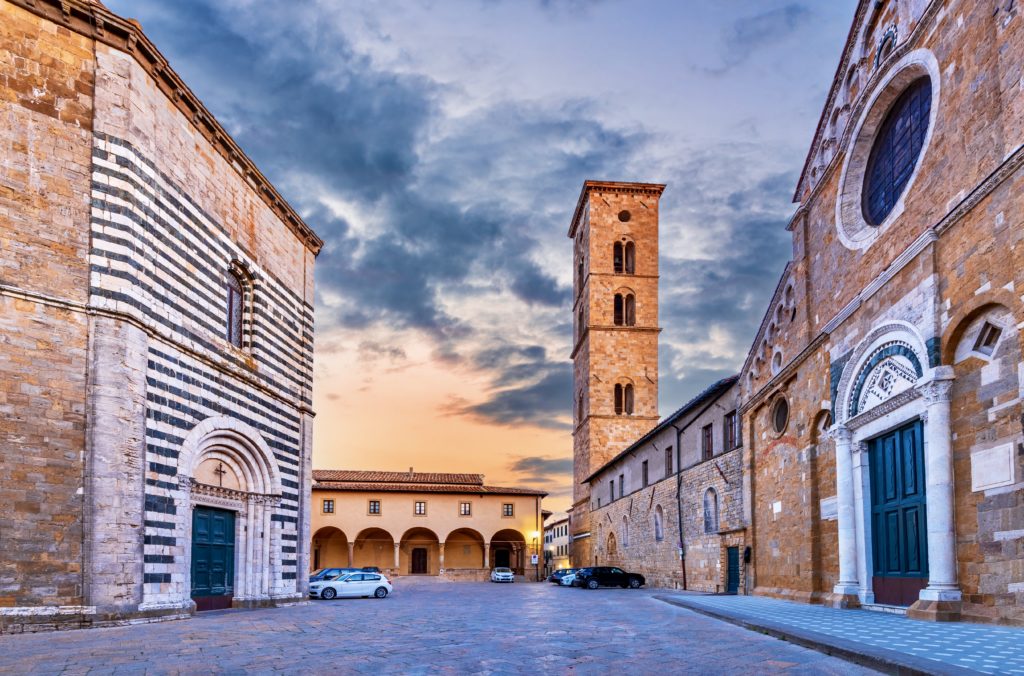
Duomo & Baptistery
If you’re in Volterra for just one day, you’ve got to check out the Duomo. This stunning cathedral was built in the 12th century and blends Romanesque and Gothic styles, so you’ll get a real sense of the town’s architectural history.
Oh, and the bell tower offers up some of the best views of the town and its surroundings. Don’t forget to bring your camera!
Inside the cathedral, you’ll find an array of beautiful artwork, from frescoes to paintings to a stunning carved pulpit. One of the main attractions is a Deposition, which is a must-see masterpiece. And don’t forget to look up — the blue Renaissance ceiling with a starry sky is a real showstopper.
After the cathedral, be sure to head behind it to check out the octagonal Baptistery. This structure dates back to the 13th century and is adorned in striped marble bands that are typical of Pisan architecture. Once you’re inside, you can admire the ornate baptismal font created by Andrea Sarsovino.
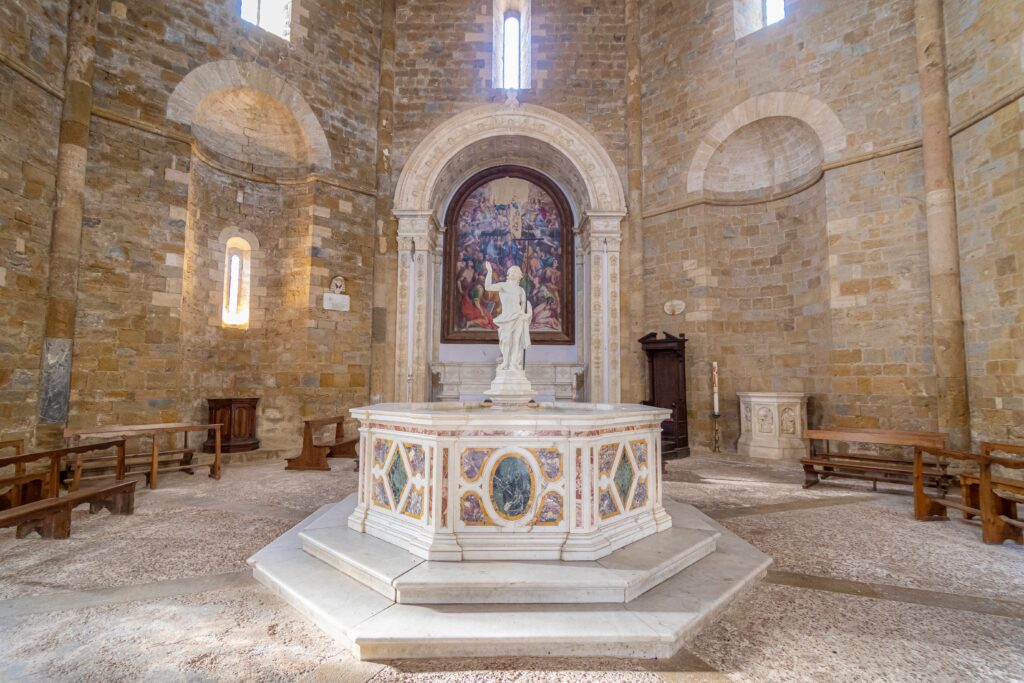
Diocesan Museum
Just south of the Baptistery on Via Roma is the Museo Diocesan d’Arte Sacra, housed in the Palazzo Vescovile.
This small museum is rich in paintings, sculptures, and artifacts. Highlights include a bust of St. Linus by Andrea della Robbia and a Madonna Enthroned with Saints by Rosso Fiorentino.
In addition to the permanent collection, the museum also hosts temporary exhibitions throughout the year.
The museum is open daily, except for Mondays, and there is a small admission fee.
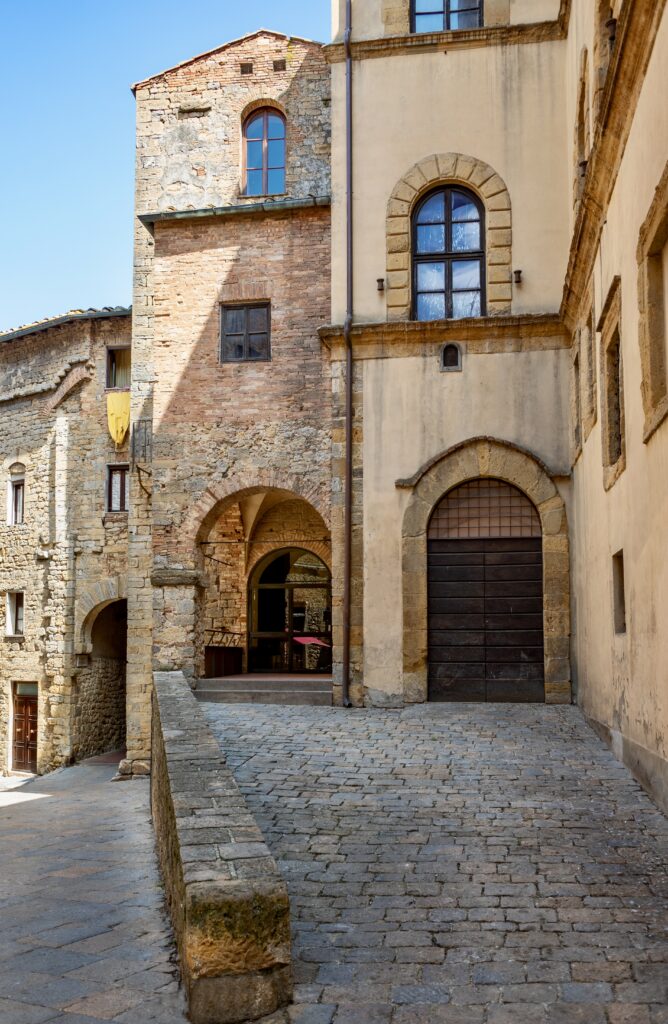
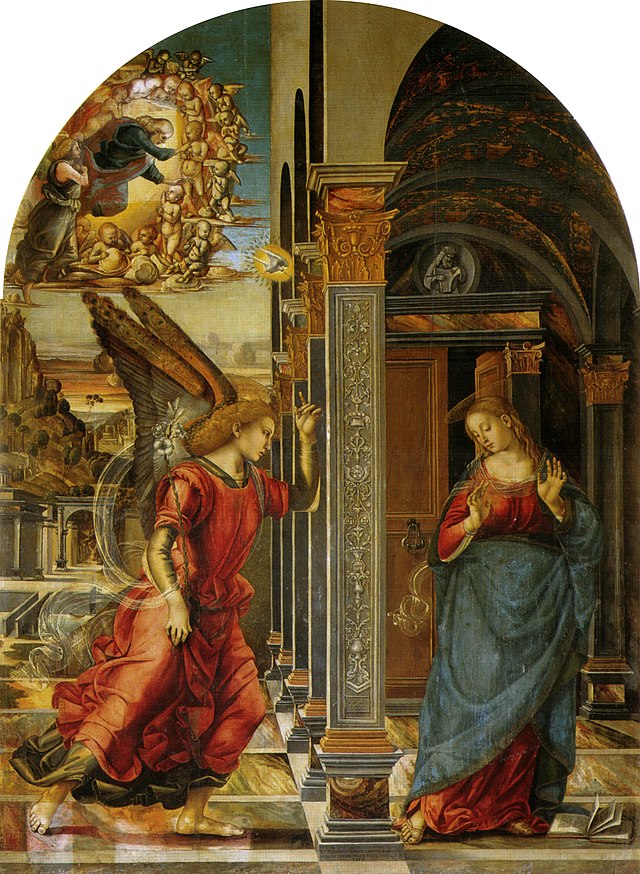
Pinacoteca
If you need more art, head to the Civic Art Museum, also known as the Pinacoteca. It’s one of the main cultural attractions in Volterra.
The museum is housed in the Palazzo Minucci-Solaini, a beautiful 16th-century Renaissance palace located in the historic city center. The palazzo was built by the wealthy Solaini family and later became the property of the Minucci family.
The Pinacoteca features an impressive collection of artworks, including paintings, sculptures, and other artifacts from the 14th to the 20th century.
The collection is organized chronologically, and each room of the museum showcases art from a different time period. You’ll find paintings by Tuscan artists like Luca Signorelli and Taddeo di Bartolo.
The must see masterpiece is Rosso Fiorentino’s Descent from the Cross. Art historians consider it a masterpiece of Mannerism.
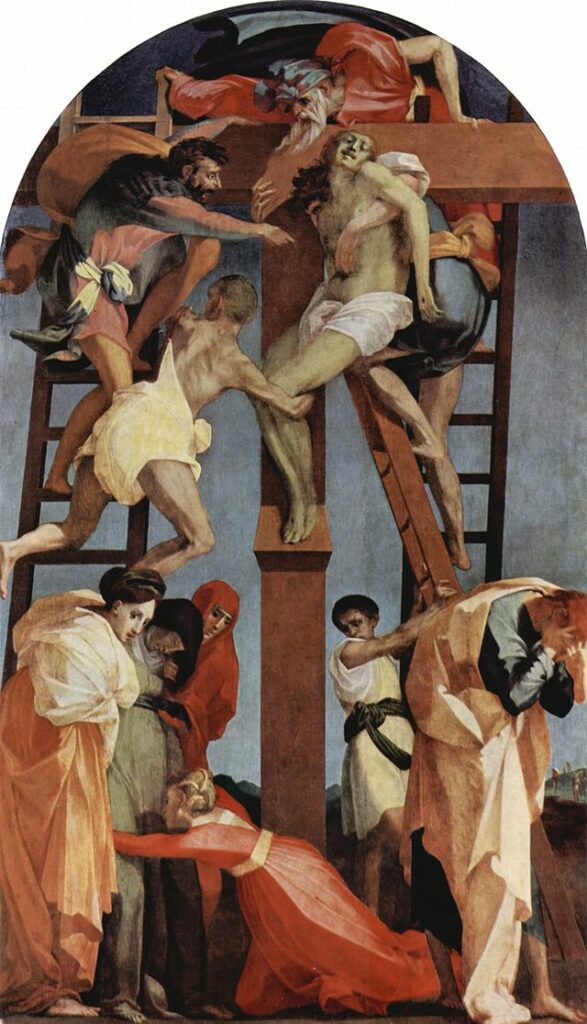
Alabaster Museum
As an alternative to the the Pinacoteca, you could consider visiting the Alabaster Museum. The museum is housed in the impressive Renaissance-era Palazzo Incontri-Viti. It showcases the history and artistry of alabaster, a unique translucent mineral that is found abundantly in the surrounding hills.
The exhibits in the museum are arranged chronologically, tracing the development of alabaster art from the Etruscan period to the present day. The museum features an impressive collection of sculptures, reliefs, and decorative objects.
One of the museum highlights is a display of antique Etruscan urns. In addition, there are beautiful works from the medieval and Renaissance periods, including a stunning 15th century altarpiece.
Throughout the museum, visitors can learn about the geology and mining techniques involved in the production of alabaster. Kids may like the demonstrations by skilled artisans, who show how the stone is carved into beautiful works of art.
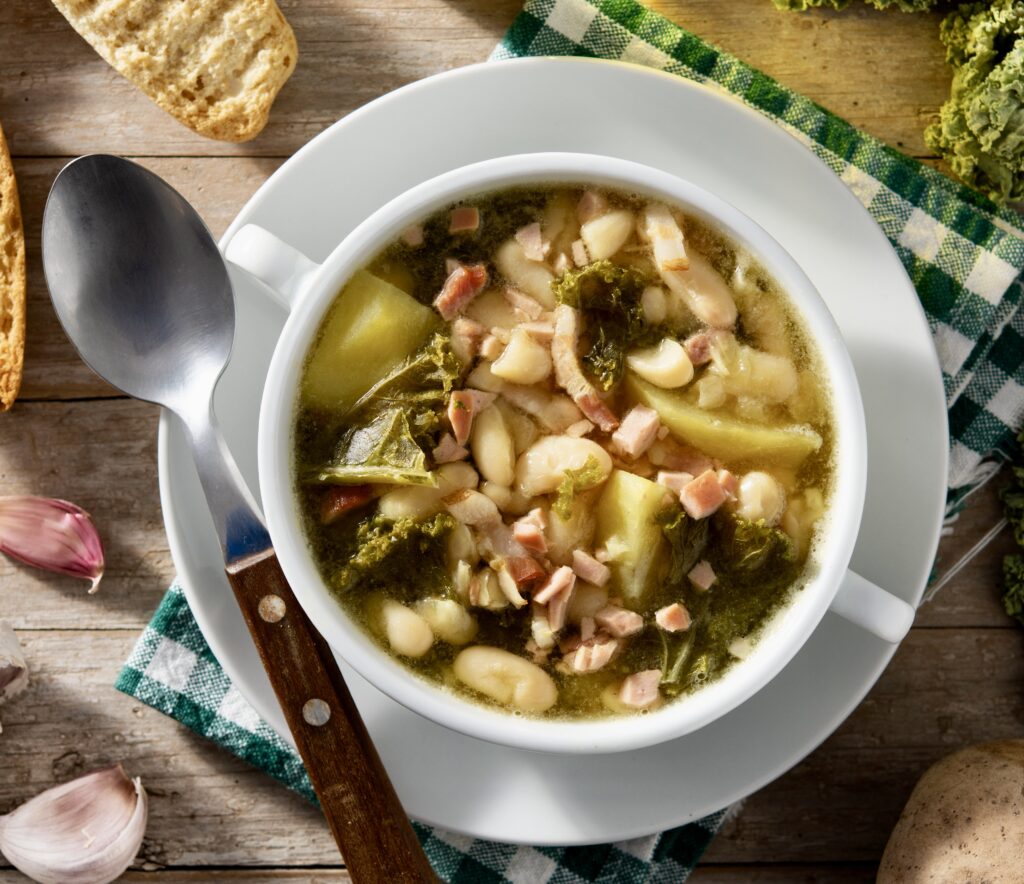
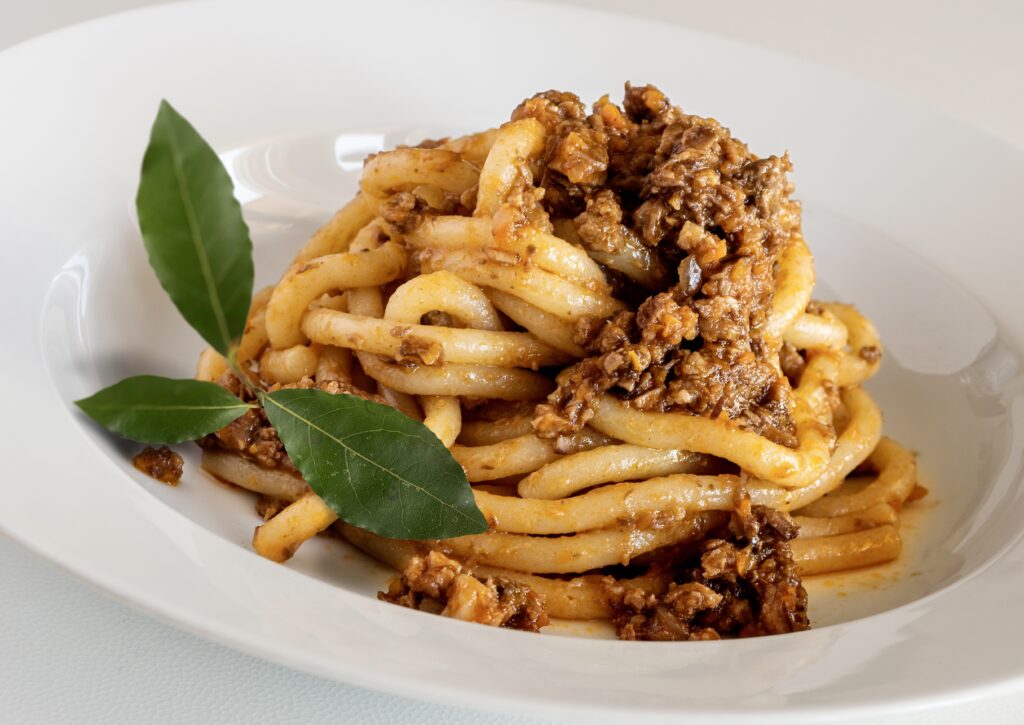
If you’re looking for things to do in Volterra during the evening, there are plenty of options available.
First and foremost, Volterra is known for its wine, and there are many excellent wine bars in town where you can enjoy an aperitivo. Two great options are Enoteca Del Duca and La Vena di Vino.
Volterra also has a number of excellent restaurants serving up delicious Tuscan cuisine. I liked the cozy little La Vecchia Lira on Via Matteotti, with excellent pasta dishes. Osteria dei Poeti is another atmospheric place with stone walls and vaulted ceilings.
Finally, you might want to check whether there are any performances taking place at the Roman Theater. During the summer months, it hosts concerts and other cultural events, making for a memorable evening experience.
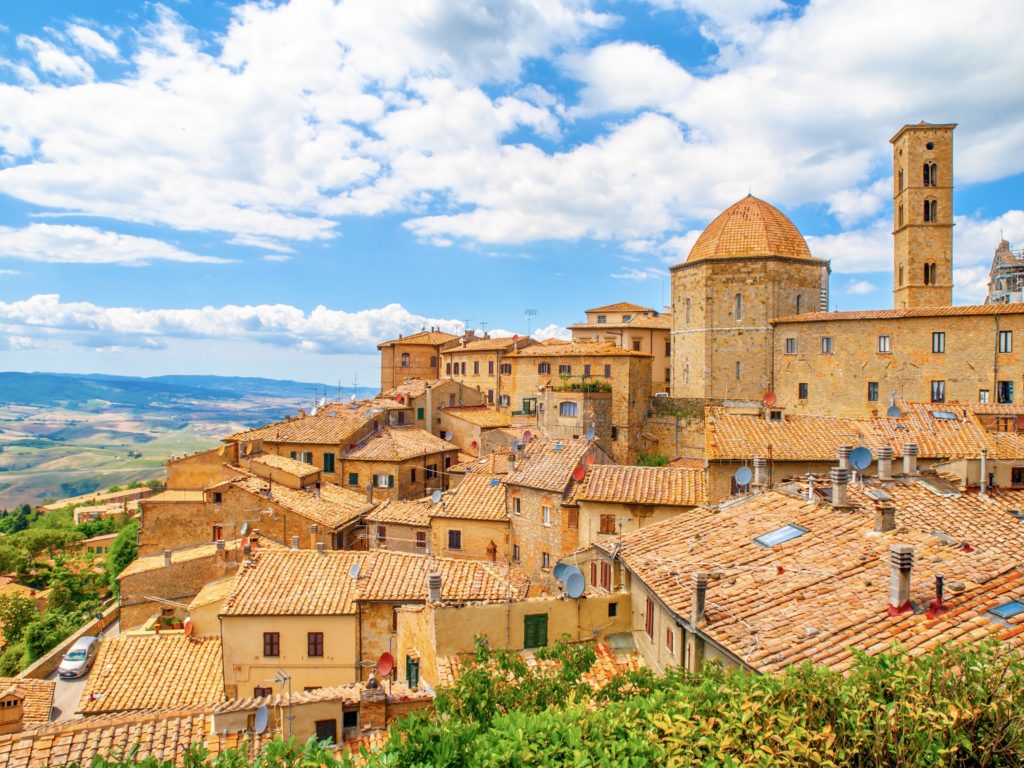
Tips For A One Day In Volterra Itinerary
Here are some must know tips for spending 1 day in Volterra.
1. How To Get To Volterra
Volterra is a beautiful town located in the heart of Tuscany. There are a few ways to get to Volterra, but driving is the easiest option.
Keep in mind that the town center is pedestrianized, so you’ll need to park your car outside the town. The best parking options are the lots by the Porta a Selci or the Porta Fiorentina. If you’re planning to visit the Roman Theater first, it’s best to park in the lot near the Porta a Selci.
If you’re coming by train, the nearest train station is in the town of Pontedera, which is about 19 miles away. From there, you can either take a bus or rent a car to reach Volterra.
You can also get to Volterra on a guided day tour from Siena or a guided tour from Florence.
Once you’re in Volterra, the best way to explore the town is on foot. The historic center is mostly pedestrian-only, which makes it easy to walk from one attraction to another. There are some steep streets and steps to navigate. But it’s all very doable with some comfy walking shoes.
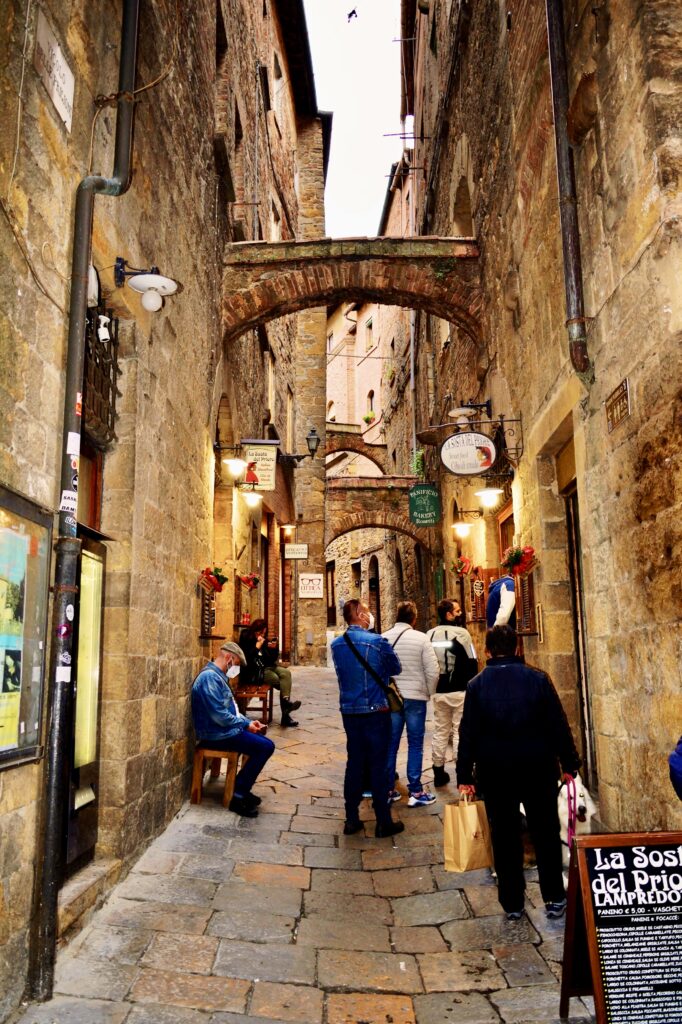
2. Where To Stay In Volterra
If you want to stay in the historic center of Volterra, La Bandita Townhouse will fit the bill. It’s a luxurious boutique hotel with a rooftop terrace and a spa.
If you’d prefer to stay in he countryside (I would!), Castello di Vicarello is just a short drive from Volterra. It’s a restored medieval castle features antique furnishings and breathtaking views of the surrounding landscape.
Another lovely place is the Borgo Pignano. The hotel features 14 luxurious suites, a restaurant serving farm-to-table cuisine, and an outdoor pool with views.
3. When To Visit Volterra
Volterra is at its best during spring or fall when the temperatures are mild and there are fewer crowds. Summer is the busiest time, and it can be quite hot.
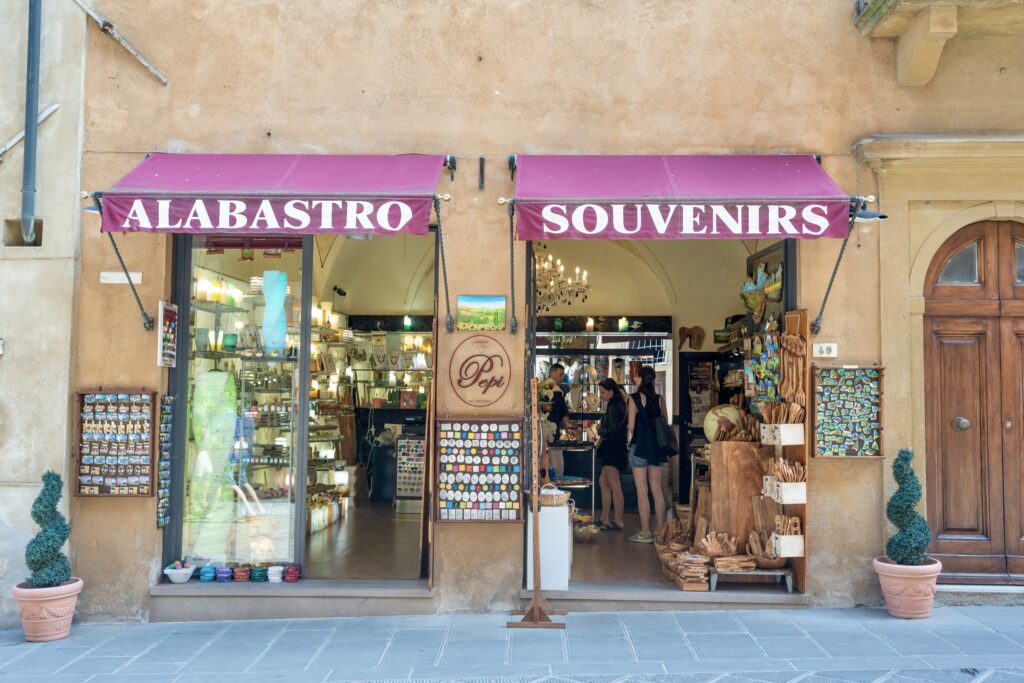
4. Shopping In Volterra
Volterra is known for its high quality alabaster products. You can buy carved figurines or vases.
You can also find some of the usual Tuscan artisan crafts — olive wood, leather goods, ceramics, and artisanal food stuffs.
5. Is One Day Enough In Volterra?
Volterra has a long list of museums and attractions, but they can be covered in one full day. With only a half day, I would cut down on museums, climb the tower, and stroll the picturesque streets.
6. Is Volterra Worth Visiting?
Volterra is definitely worth visiting, especially for history buffs. It’s a charming hilltop town with a historical attractions and scenic beauty.
Volterra has a well-preserved historic center, including ancient Etruscan and Roman ruins, medieval towers and palaces, and a beautiful cathedral.
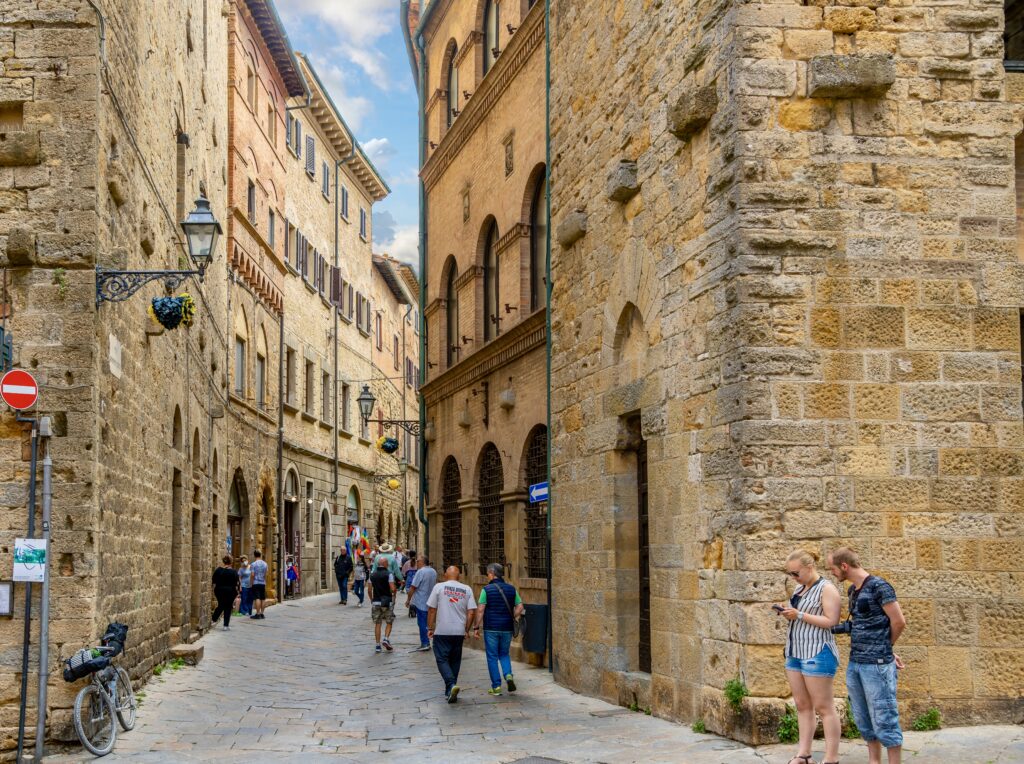
7. More Than One Day in Volterra?
If you have more than 1 day in Volterra, there are plenty of other things to do in and around Volterra.
You could visit the Fortress Medicea. It’s located on a hilltop east of Volterra. It’s now a prison, but you can climb the tower with a guide for some fantastic views.
It’s a bit hard to find. But, on the end of the Via Matteotti, you will see a large archway and a set of stairs that lead to the fortress.
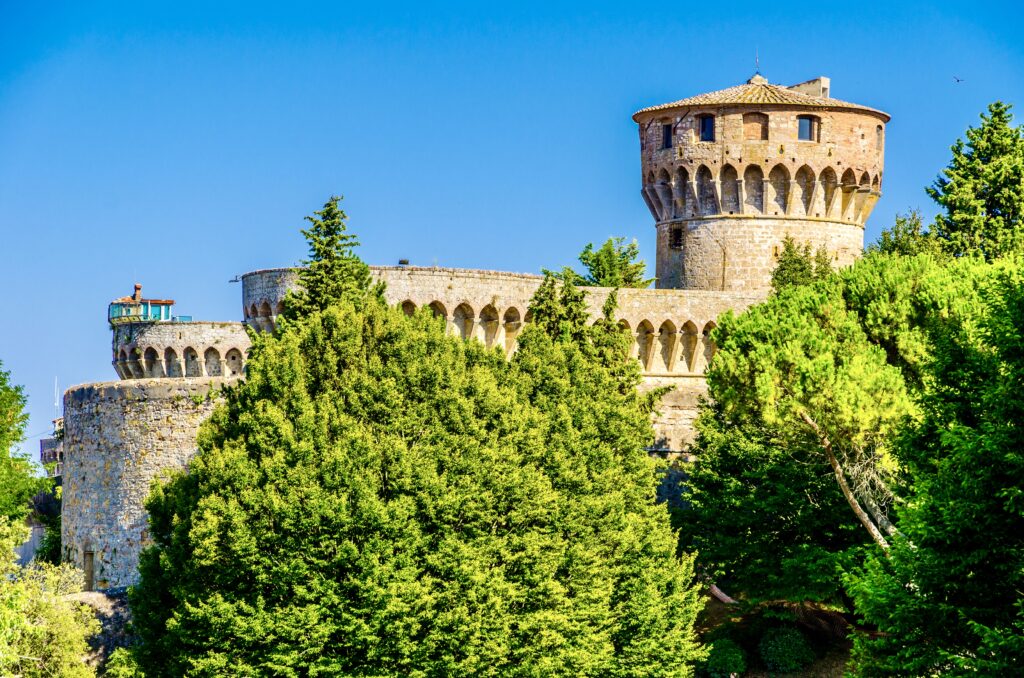
Another place for history buffs is the Necropolis of Marmini. It’s an ancient Etruscan burial site that dates back to the 6th century B.C.
It is located just 1 mile outside Volterra and has several tombs that have been excavated and preserved. The tombs at Marmini are carved out of the soft tufa rock and feature intricate decorations and frescoes that depict scenes from Etruscan mythology and daily life.
Want a cute medieval town instead? San Gimignano is a beautiful medieval town that’s only 16 miles from Volterra. You’ll be delighted by San Gimignano’s famous towers, exceptional artworks, and exquisite churches.
Siena is one of the most beautiful towns in Italy and just 30 miles from Volterra. For everything to do in Siena, you can check out my 1 day in Siena itinerary and my 2 days in Siena itinerary.
I hope you’ve enjoyed my one day in Volterra itinerary. You may find these other Italy travel guides and resources useful:
- 3 day itinerary for Rome
- 5 day itinerary for Rome
- 1 day itinerary for Vatican City
- 3 day itinerary for Florence
- 2 day itinerary for Venice
- 1 day itinerary for Milan
- One week in Umbria
- 10 days in Italy itinerary
- 10 day itinerary for Tuscany
- 12 ways to spend 1 week in Italy
- 2 weeks in Sicily itinerary
If you’d like to spend one day in Volterra, pin it for later.

